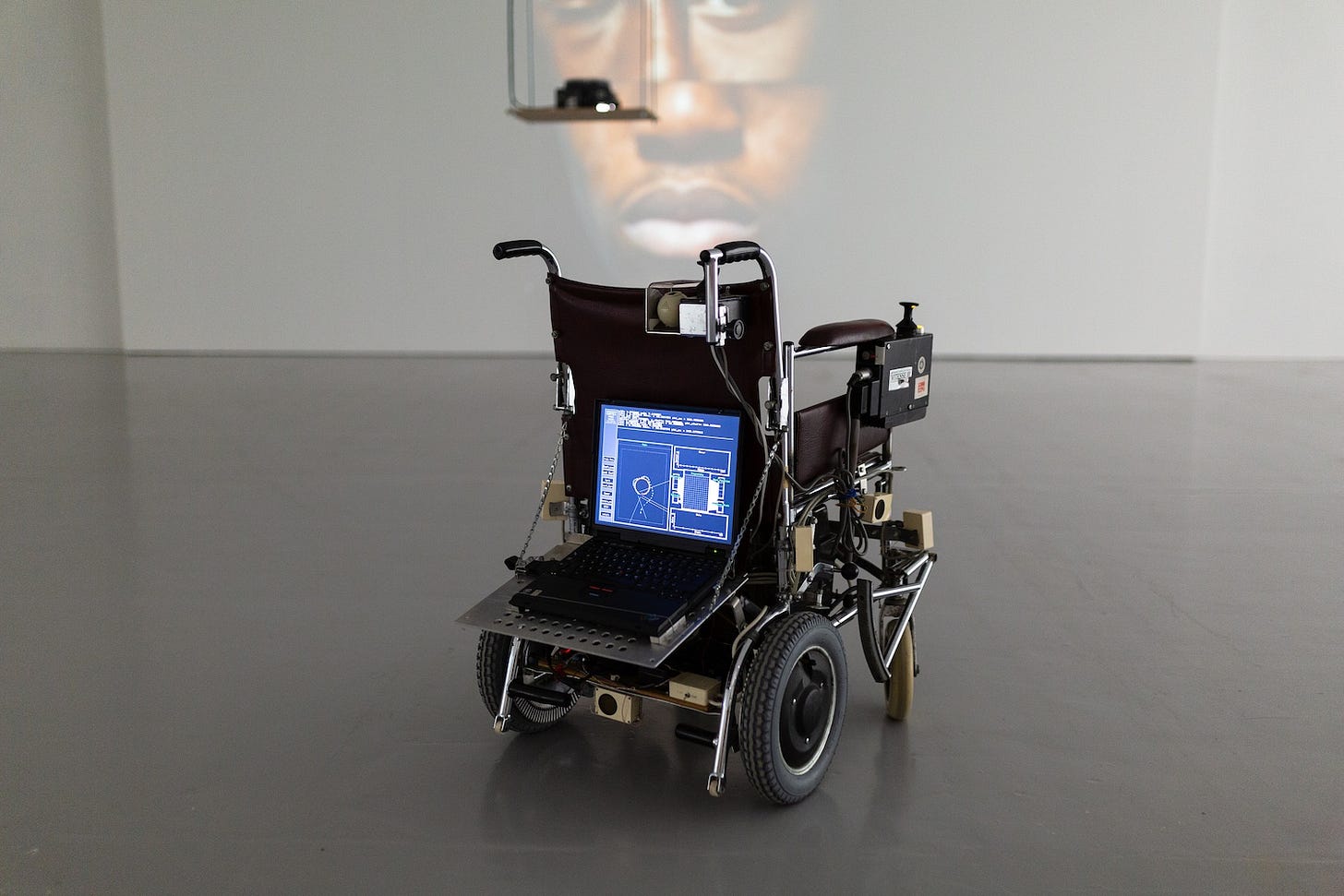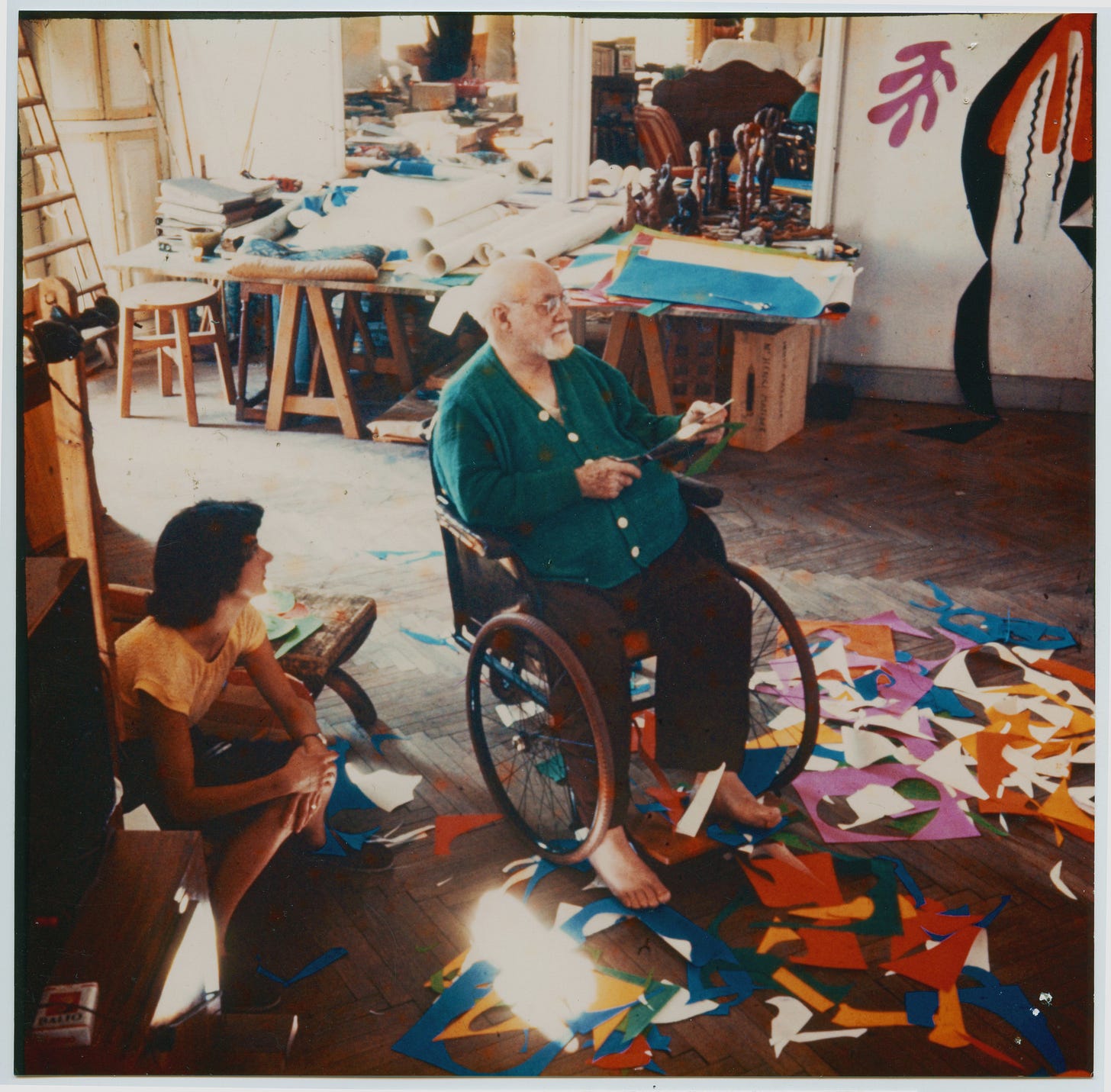Donald Rodney at Whitechapel Gallery
In Donald Rodney's "Psalms," a 1990s motorized wheelchair roams the gallery.
This past weekend, I visited the exhibit Donald Rodney: Visceral Canker at London’s Whitechapel Gallery. It went on my list after seeing a social media video of one of the works, Psalms: a 1990s motorized wheelchair that roams the gallery, guided by a laptop strapped to its back and sensors on its sides.
Donald Rodney (1961-1998) was a British artist born to Jamaican parents in the West Midlands. He had sickle cell anemia, spending much of his life navigating treatment and eventually becoming a wheelchair user. Rodney’s work explores race, disability, illness, technology, prejudice, state violence, and more. He first came to prominence as part of the BLK Art Group, which organized events and exhibits of Black artists in Britain in the 1980s.
***
As a motorized wheelchair user, Psalms piqued my interest. I tried to recall whether I had ever seen someone use their own wheelchair in an art piece,1 and invited my friend Sophia (a manual chair user herself) to come along.
The chair is Psalms was used on and off by Rodney towards the end of his life; its beautiful burgundy leather marked by years of use.2
Video description: Anna circling Psalms in the gallery. Both chairs click and Sophia, taking the video, says “You look like you’re doing a dance together.” Credit: Sophia Borovick.
We crossed the gallery for a closer look — conscious that our trinity was being observed with unsubtle interest by the bipeds with which we shared the space
Rodney’s chair moved cautiously, inching slowly forward for a few turns of its wheels before angling left or right, and repeating the process at random. Having only seen a short video clip of Psalms beforehand, I’d assumed the chair just rotated itself in a small circle. I was awed to see it instead roaming freely, and as I got closer, heard its motors clicking as it stopped and started — the exact sound that my chair makes, and was making, as I ambled throughout the gallery.
The sounds my wheelchair makes have always raised mixed feelings for me, largely because of the attention they draw. A “beep beep” every time I press the on button, a sharp click that sounds like the crack of a whip each time I push or let go of the joystick, a humm as I move — all unfamiliar to the nondisabled ear, garnering sharp looks of curiosity or annoyance as I move my body in abled spaces.
But when I hear these sounds come from other wheelchair users, they feel like home. When in the library at the end of the day, a beep-beep says “I’m getting ready to leave.” In a museum exhibit, a click is a question: “I’m ready to move to the next painting. Are you?” or if we’ve separated, a reminder, “I’m over here, to the left in the next room.”
Rodney’s chair and mine were clicking and clacking to one another across the space, having a conversation in a language only we knew. It (he?) felt like kin.
Video description: More gallery footage of Psalms as it moves. Chatter in the background. Credit: Sophia Borovick.
Diane, Donald Rodney's partner and an artist herself, was one of the people in the gallery that day. She watched as Sophia and I danced with Psalms, and eventually struck up a conversation with us. Diane and I were amused to observe that with the chair's navigation sensors seemingly a bit impaired that day, it never ventured far from our group as we stood to the side of the room and conversed. It’d venture an arm’s length away before meandering back, sidling right next to my chair.
"It wants to hang out with us," I joked. "It knows we're the cool place to be."
"He does," she replied.
At one point, having gently caught itself onto one of my back wheels, the chair became stuck. We laughed.
"I do that to some of my friends who have power chairs too," I said. "I call them 'love taps.'"
I'm not sure how much time we spent with Psalms, but it had to be at least an hour. I was loath to leave it. Upon our exit from the gallery, Sophia and I had to double back through the rooms to get to the lift, passing Psalms for the second time. I approached it again, sighing and smiling ruefully. "I'm going to miss you … and that is weird." We sat for another minute before my chair’s motor answered it with a click for the last time: "Goodbye!"
***
Rodney was concerned with how (or if) he would be remembered, given his fragile health and likelihood of a shortened lifespan. Before his death, he collaborated with Mike Phillips to create AUTOICON,3 an internet work finished after his death that, using early AI and aural networks, “simulates both the physical presence and elements of the creative personality of the artist Donald Rodney.” Users can “talk” to Rodney by typing into a text box, and the program will “respond” — typically with a photo of Rodney’s work, a recording of his voice, or a box of text quoting him.
Video description: A screen recording of AUTOICON projected onto a wall. Many small windows showing text and photos litter the 1990s-looking software. Subtitles appear at the bottom in time with muffled recordings of Rodney’s speech: “I couldn’t stand for very long,” then “When you look at the piece, it’s quite a beautiful picture. You walk up to it, and you’re quite beguiled by it, by the X-rays for one thing and also by the colours, you’re sort of drawn into it.”
AUTOICON is an embodiment (or disembodiment) of the uncanny; its responses are awkward, often disconnected or wildly off-topic from the question or comment fed into it. In the screen-recording of its use shown in the exhibit, the person typing often asks something several times, phrased in different ways, to prompt the desired response.
But on occasion, the phrase or artwork that pops up flows perfectly — and just for a second, it feels as if Rodney may actually be there answering. For me, the work raised endless questions about ethics, agency, memorial and remembrance, artificial intelligence (especially its affinity for mimicry and removing information from its context), and how our work and thoughts will be used after we’re gone.4
AUTOICON, along with Psalms, show Rodney’s penchant for the innovative fusion of technology and art. But strangely, it wasn’t the former which made me feel like I was in communication with his memory.
***
The work for which the exhibition was named, Visceral Canker, consists of two large wooden plaques, one bearing the coat of arms of Queen Elizabeth I, and the other of John Hawkins, who was granted a ship by the Queen to “trade” enslaved people. Each plaque is connected to a hospital blood bag, clear tubes, and pumps which circulate the blood through the work.
Video description: Blood pumps through Visceral Canker. Chatter in the background.
But equally as interesting as the work are the disability politics of its eventual display: Rodney originally planned to use his own blood, symbolizing his bodily connection to this history, as a Black British man. But word of this reached Plymouth City Council, the organization managing the public art project for which the work was made. They told Rodney that if the work contained his sickle cell blood, they would not allow it to be displayed — a decision perhaps informed by the panic of that era over blood-borne diseases like HIV/AIDS, despite the fact that sickle cell anaemia is a genetic condition, and not contagious.
Rodney grudgingly used theatrical blood instead, and can be seen on camera later in the exhibition expressing his hope that the work can be shown one day in its intended form, with his own (Black, sick, controversial) blood. Its title, Visceral Canker, refers to the visceral nature of the artist’s work, and its exploration, often through his own disabled body, of the ‘canker’ or disease in society.
***
In an “archive” room after the exhibition, a long slideshow circulates dozens of photographs of Rodney’s works which are, unfortunately, lost. According to Diane, this is due to a combination of factors including their limited living space and repeated moves5 as well as his liking for fragile and unconventonal materials — a penchant which, Sophia and I theorized, may have partially been Rodney’s way to make the act of creation more accessible for himself during times of less mobility.
In many cases, he seemed to have a tendency for modular works made out of many pieces, like X-rays or pieces of paper, which could then be assembled together on a gallery wall. This brings to mind Matisse’s move to cut-outs when he became a wheelchair user — cutting paper with scissors could be done from a seat or bed more easily than painting, and later assembled. (The cut-outs are now recognized as some of Matisse’s best, most innovative work.)
It is likewise remarkable that in his short life, Rodney was so prolific. His entire body of work was created in his twenties and thirties, before his death at 36. It is difficult not to imagine what more he would have created if he had more time, not to mention the technological, disability rights, and accessibility advancements of the 2000s and beyond. In the final part of the exhibit, there’s a short film (3 Songs on Pain, Light & Time by the Black Audio Film Collective) where Rodney mentions next wanting to create art exploring Black male sexuality.
In that film, Rodney talks broadly about himself and his art, including Psalms. He says the piece was intended to convey loneliness, and an aimless pursuit for something that will never be realized. I felt a pang when I heard this. That wasn’t how Psalms made me feel — quite the opposite. I felt like I was among kin, in community, and had found joy.
I wonder if, given more time — or less pain from racist medical malpractice, life in a decade where disabled people had access to trains and buses, access to a disability pride movement — Rodney would have come to see his wheelchair as a tool for freedom and a source of positive identity. But such a thing remains a journey that takes many of us decades, if it happens at all.
***
If this article made you want to see Rodney’s work yourself, I’m sorry to say that I visited on the last day of the Whitechapel exhibition. Psalms has, however, been acquired by the Tate, and Diane spoke of her (and our) hope that it may go on display there at some point. I can’t help but think about how much the lovely, burgundy chair would enjoy meeting more wheeled friends.
Tony Heaton’s piece, also a favorite of mine, is made of discarded hospital wheelchairs.
“I wish my chair was that nice — I love that color,” I remarked to Sophia. She agreed, spurring an exchange of humorous resentment towards what we decided was a clear aesthetic decline from Rodney’s chair to ours, all plastic and nylon.
Referencing Jeremy Bentham’s self-envisioned preserved skeleton, of the same title.
I am reminded of the AI Anne Frank, which came under fire for urging schoolchildren not to blame anyone for the Holocaust.
They had trouble finding wheelchair accessible housing in London -- how familiar.





